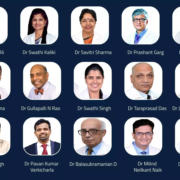1. Dr Mohd Javed Ali:
Dr. Javed Ali is a renowned oculoplastic surgeon specializing in state-of-the-art lacrimal surgeries and is a leader in advances of the lacrimal drainage sciences. He currently heads the Govindram Seksaria Institute of Dacryology at the L.V. Prasad Eye Institute, India. Javed is also the Distinguished Alumni Chair of Ophthalmology at the L.V. Prasad Eye Institute and the current Editor-in-Chief of Seminar in Ophthalmology. He holds international Professorships at the National University of Singapore, University of Shanghai, Krasnov Research Institute in Russia, and at WIM, Warsaw.
Dr. Ali has been recognised as one of the top 2% scientists across the world, as per Stanford University’s list of 2025. He holds a rank of 9095 in the list based on the composite score excluding self-citations, and 78597 when all citations are included. By the end of 2024, his h-index, excluding self-citations, stands at 9, with altogether 686 citations for 2024 (excluding self-citations).
2. Dr Swathi Kaliki:
An internationally recognized Ocular Oncologist, Dr. Swathi Kaliki currently heads the Operation Eyesight Universal Institute for Eye Cancer and the Ophthalmic Plastic Services at the L V Prasad Eye Institute, India.
Dr. Kalki has been recognised as one of the top 2% scientists across the world, as per Stanford University’s list of 2025. She holds a rank of 69975 in the list based on the composite score excluding self-citations, and 64062 when all citations are included. By the end of 2024, her h-index, excluding self-citations, stands at 11, with altogether 761 citations for 2024 (excluding self-citations).
3. Dr Savitri Sharma:
After pursuing her MBBS from VSS Medical College, Burla, Sambalpur, Odisha, Dr. Sharma pursued MD (Medical Microbiology) from Jawaharlal Institute of Postgraduate Medical Education and Research (JIPMER), Pondicherry in 1982. She joined L V Prasad Eye Institute (LVPEI), Hyderabad in 1991 and established the ocular microbiology and clinical pathology services of the institute. Three decades on, the institute has recognized her contribution to ocular microbiology and instituted ‘Dr Savitri Sharma Chair of Ocular Microbiology’ in her name. Currently, she is the Director Emeritus, Laboratory Services – LVPEI Network and a visiting faculty member at LVPEI.
Dr. Sharma has been recognised as one of the top 2% scientists across the world, as per Stanford University’s list of 2025. She holds a rank of 73464 in the list based on the composite score excluding self-citations, and 78526 when all citations are included. By the end of 2024, her h-index, excluding self-citations, stands at 14, with altogether 5380 citations for 2024 (excluding self-citations).
4. Dr Prashant Garg:
An internationally renowned leader in corneal infections, anti-microbial resistance and eye banking, Dr. Prashant Garg is the Executive Chair LVPEI, succeeding the founder Chairman Dr Gullapalli N Rao. He received numerous prestigious awards, both national and international, and he is on the Boards of several international organizations, societies and scientific journals.
Dr. Garg has been recognised as one of the top 2% scientists across the world, as per Stanford University’s list of 2025. He holds a rank of 90300 in the list based on the composite score excluding self-citations, and 88664 when all citations are included. By the end of 2024, his h-index, excluding self-citations, stands at 11, with altogether 594 citations for 2024 (excluding self-citations).
5. Dr Sayan Basu:
Dr. Sayan Basu is the Prof. D. Balasubramanian Chair of Eye Research and serves as the Director of both the Prof. Brien Holden Eye Research Centre (BHERC) and the Centre for Ocular Regeneration (CORE). He is also an Adjunct Associate Professor of Ophthalmology at the University of Rochester, NY, USA.
Dr. Basu has been recognised as one of the top 2% scientists across the world, as per Stanford University’s list of 2025. He holds a rank of 102331 in the list based on the composite score excluding self-citations, and 102815 when all citations are included. By the end of 2024, his h-index, excluding self-citations, stands at 12, with altogether 697 citations for 2024 (excluding self-citations).
6. Dr Rohit Khanna:
Dr Rohit C Khanna is the Network Director for the Public Health Unit of LVPEI – The Gullapalli Pratibha Rao International Centre for Advancement of Rural Eye Care. He is also an Adjunct Associate Professor of Ophthalmology at school of Medicine and Dentistry, University of Rochester, USA, and Conjoint Associate Professor at the University of New South Wales, Australia.
Dr. Khanna has been recognised as one of the top 2% scientists across the world, as per Stanford University’s list of 2025. He holds a rank of 114263 in the list based on the composite score excluding self-citations, and 111687 when all citations are included. By the end of 2024, his h-index, excluding self-citations, stands at 11, with altogether 2071 citations for 2024 (excluding self-citations).
7. Dr Gullapalli N Rao:
Dr. Gullapalli N Rao is the founder-chair of L V Prasad Eye Institute. He received his basic medical education in Guntur, Andhra Pradesh, and completed his postgraduate residency training at Dr. Rajendra Prasad Centre for Ophthalmic Sciences, All India Institute of Medical Sciences, New Delhi. In the US, he trained at Tufts University School of Medicine in Boston, and later at the School of Medicine, University of Rochester, where he continued on the faculty until 1986.
Dr. Rao has been recognised as one of the top 2% scientists across the world, as per Stanford University’s list of 2025. He holds a rank of 124990 in the list based on the composite score excluding self-citations, and 131627 when all citations are included. By the end of 2024, his h-index, excluding self-citations, stands at 8, with altogether 455 citations for 2024 (excluding self-citations).
8. Dr Swathi Singh:
Dr. Singh has been working as the Associate Ophthalmologist at the L V Prasad Eye Institute since January 2021. She manages and treats patients with dry eye disease, ocular surface diseases like Stevens-Johnson syndrome and patients requiring eyelid surgeries. Her current focus of interest is improving tear production in patients with dry eye disease.
Dr. Singh has been recognised as one of the top 2% scientists across the world, as per Stanford University’s list of 2025. She holds a rank of 125912 in the list based on the composite score excluding self-citations, and 90746 when all citations are included. By the end of 2024, her h-index, excluding self-citations, stands at 8, with altogether 389 citations for 2024 (excluding self-citations).
9. Dr Taraprasad Das:
Dr Das is the Vice Chairman Emeritus of the L V Prasad Eye Institute. He is Professor of Ophthalmology at the Sun Yet-Sen University, Guangzhou, China; and Adjunct Professor of Ophthalmology at University of Rochester Medical School, Rochester, NY, USA; and Fellow, National Academy of Medical Sciences, India.
He has delivered 13 named lectures, has received 24 awards from state and national societies (1993- 2015) in India, from the Asia Pacific Academy of Ophthalmology (APAO, 2006 and 2013) and the American Academy of Ophthalmology (AAO, 2003 and 2015). He was conferred Doctorate of Science (Honaris Causa) by the Raveshaw University in year 2011. Government of India conferred high civilian honor (Padma Shri) in year 2013.
Dr. Das has been recognised as one of the top 2% scientists across the world, as per Stanford University’s list of 2025. He holds a rank of 179235 in the list based on the composite score excluding self-citations, and 109745 when all citations are included. By the end of 2024, his h-index, excluding self-citations, stands at 7, with altogether 486 citations for 2024 (excluding self-citations).
10. Dr Jill Elizabeth Keeffe:
Dr. Keffe is a faculty member at the L.V. Prasad Eye Institute in Hyderabad, India, where she works for the advancement of rural eye care and vision rehabilitation.
Dr. Keeffe has been recognised as one of the top 2% scientists across the world, as per Stanford University’s list of 2025. She holds a rank of 215079 in the list based on the composite score excluding self-citations, and 224752 when all citations are included. By the end of 2024, Her h-index, excluding self-citations, stands at 14, with altogether 1438 citations for 2024 (excluding self-citations).
11. Dr Vivek Singh:
Dr Vivek Singh is an expert in limbal stem cell culture, immunohistochemistry, confocal & fluorescence microscopy, generating mice chimaeras, animal cell culture and different animal models for clinical research. His lab combines various cell biology, molecular biology, and bioengineering approaches to address the scientific questions mainly related to ocular surface diseases and focuses on the research of corneal wound healing, regenerative biology, Animal models in Ophthalmology, biomaterials, Dry eye disease, Steven-Johnson syndrome, Simple limbal epithelial transplantation.
He is the assistant editor of the International Journal of Applied Sciences and Biotechnology and also a member of the Advisory Board of the Indian Journal of Scientific Research.
Dr. Singh has been recognised as one of the top 2% scientists across the world, as per Stanford University’s list of 2025. He holds a rank of 240125 in the list based on the composite score excluding self-citations, and 233271 when all citations are included. By the end of 2024, his h-index, excluding self-citations, stands at 9, with altogether 458 citations for 2024 (excluding self-citations).
12. Dr Pavan Kumar Verkicharla:
Dr Pavan Verkicharla is the Scientist researching on both basic and translational aspects of myopia at the myopia research lab in L V Prasad Eye Institute, India. He heads ‘The Myopia Centre’ at the LVPEI where they actively provide various anti-myopia strategies.
He is a committee member and an ambassador for International Myopia Institute and serves as a reviewer for various optometry/ophthalmology scientific journals. Dr Pavan Verkicharla is a recipient of the prestigious “Bernard Gilmartin Award” from college of optometrists, UK and the “INSPIRE Faculty Award” from the DST-Government of India. He holds grants from both private organizations and the government of India for researching various aspects of myopia through a holistic approach.
Dr. Verkicharla has been recognised as one of the top 2% scientists across the world, as per Stanford University’s list of 2025. He holds a rank of 263804 in the list based on the composite score excluding self-citations, and 261430 when all citations are included. By the end of 2024, his h-index, excluding self-citations, stands at 11, with altogether 337 citations for 2024 (excluding self-citations).
13. Dr Balasubramanian D:
Professor D Balasubramanian joined LVPEI’s Prof Brien Holden Eye Research Centre in 1998. In January 2016 he retired from the post of Research Director, Prof Brien Holden Eye Research Centre, and continues as a Distinguished Scientist there. His illustrious scientific career included positions such as Director, Centre for Cellular and Molecular Biology, and Professor and Dean, University of Hyderabad.
He has received many awards from professional and institutional bodies including the Bhatnagar, Ranbaxy, Goyal and FICCI Prizes of India, the Third World Academy of Sciences (TWAS) Award for Basic Medical Sciences and the TWAS Award for Science Diplomacy, the Kalinga Prize for the popularization of science from UNESCO. He was honoured by the Government of India with the Padma Shri in 2002, and the Chevalier de l’Ordre National du Merite from the President of France in 2002. He has over 180 publications in national and international journals and has authored three books.
Dr. Balasubramanian has been recognised as one of the top 2% scientists across the world, as per Stanford University’s list of 2025. He holds a rank of 264281 in the list based on the composite score excluding self-citations, and 282499 when all citations are included. By the end of 2024, his h-index, excluding self-citations, stands at 7, with altogether 211 citations for 2024 (excluding self-citations).
14. Dr Milind Neilkant Naik:
After completing his postgraduate training in Ophthalmology at Christian Medical College, Vellore, Dr. Naik joined L V Prasad Eye Institute in 2001. He underwent an Oculo-Facial Plastic Surgery fellowship at the University of California, Los Angeles, USA.
Dr. Naik has 24 years of experience in Eye & Facial Plastic surgeries, and his area of expertise includes Thyroid Eye Disease, Cosmetic eyelid and facial surgery, and Reconstructive surgery around the eye and face. He has over 245 peer-reviewed publications in scientific journals, and lectures extensively across the globe.
Dr. Naik has been recognised as one of the top 2% scientists across the world, as per Stanford University’s list of 2025. He holds a rank of 279807 in the list based on the composite score excluding self-citations, and 220858 when all citations are included. By the end of 2024, his h-index, excluding self-citations, stands at 6, with altogether 294 citations for 2024 (excluding self-citations).
15. Dr Subhadra Jalali:
Best known for her work in the area of Retinopathy of Prematurity (ROP), Dr. Jalali is the Network Director – Quality at LVPEI. She is also the Director of the Newborn Eye Health Alliance (NEHA) at LVPEI that provides neonatal eye care. Dr. Jalali has been associated with KVPEI as a faculty since 1993. She is also on the National Task Force on ROP, Govt. of India, and is an expert advisor on ROP to the Governments of Bangladesh and Philippines.
Her specialization lies in managing advanced vitreoretinal conditions, ocular trauma, endophthalmitis and primary genetic retinal degenerations.
Dr. Jalali has been recognised as one of the top 2% scientists across the world, as per Stanford University’s list of 2025. She holds a rank of 335938 in the list based on the composite score excluding self-citations, and 305962 when all citations are included. By the end of 2024, her h-index, excluding self-citations, stands at 7, with altogether 296 citations for 2024 (excluding self-citations).
Lifetime Ranking, Ophthalmology, India:
As per a recent press release issued by the institute, among these 15 doctors, seven of the LVPEI-associated researchers have earned a place on the Lifetime Ranking for Ophthalmology from India. The list includes the following:
1. Dr Gullapalli N. Rao
2. Dr Savitri Sharma
3. Prof Balasubramanian D
4. Dr Mohd Javid Ali
5. Dr Prashant Garg
6. Dr Taraprasad Das
7. Dr Swathi Kaliki










